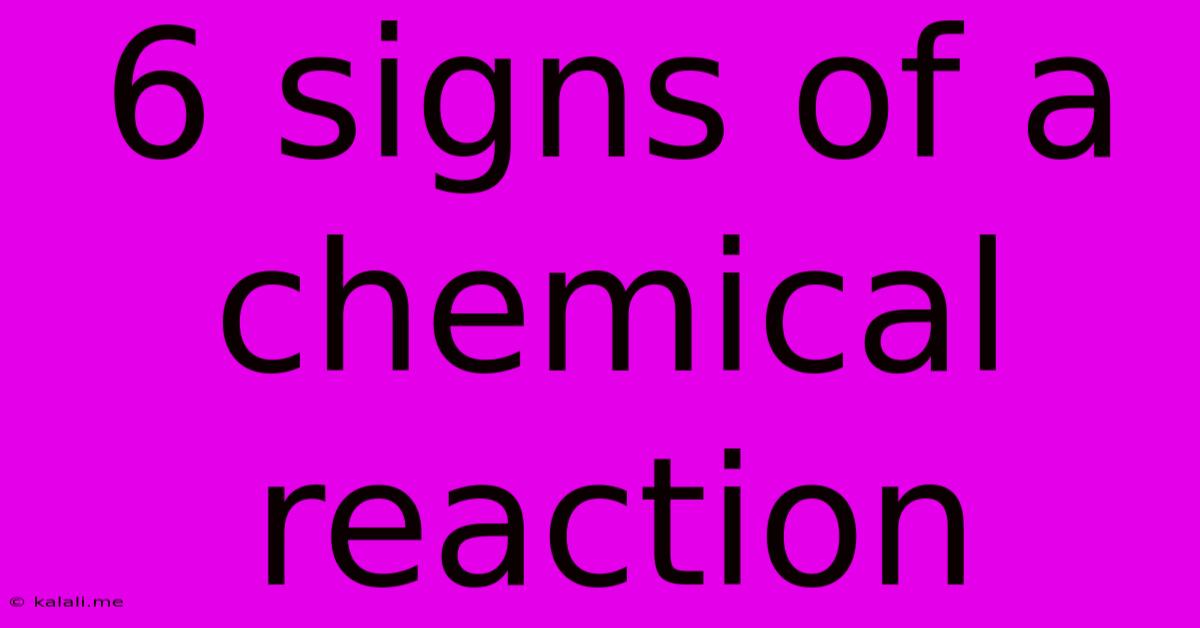6 Signs Of A Chemical Reaction
Kalali
May 10, 2025 · 3 min read

Table of Contents
6 Signs That a Chemical Reaction is Occurring
Meta Description: Learn to identify chemical reactions! This article details six key signs – temperature change, color change, gas production, precipitate formation, odor change, and light emission – helping you understand chemical processes better.
Chemical reactions are the fundamental processes that shape our world. From the rusting of iron to the digestion of food, countless chemical reactions are constantly occurring around us. But how do you know when a chemical reaction is actually taking place? While some reactions are subtle, others exhibit clear and unmistakable signs. This article will explore six common indicators that a chemical reaction is underway.
1. Temperature Change (Exothermic and Endothermic Reactions)
One of the most prominent signs of a chemical reaction is a change in temperature. Reactions can be exothermic, meaning they release heat and cause a temperature increase in their surroundings. Think of burning wood – a highly exothermic reaction that produces significant heat and light. Conversely, endothermic reactions absorb heat from their surroundings, leading to a temperature decrease. Dissolving certain salts in water is a classic example of an endothermic process. Monitoring temperature changes using a thermometer is a simple way to detect if a reaction is occurring.
2. Color Change (A Visual Cue)
A noticeable color change often signifies a chemical transformation. This is because the rearrangement of atoms during a reaction can alter the way a substance absorbs and reflects light. For example, the reaction between iron and oxygen (rusting) results in a characteristic reddish-brown color. Many chemical indicators also work based on color changes, offering a convenient way to observe reactions in a laboratory setting. Mixing different chemicals and observing if a new color emerges is a straightforward method of identifying a reaction.
3. Gas Production (Fizzing and Bubbling)
The production of a gas, often observed as fizzing or bubbling, is a strong indicator of a chemical reaction. This gas can be easily identified by its smell or by using specific tests. The reaction between baking soda (sodium bicarbonate) and vinegar (acetic acid) produces carbon dioxide gas, which causes noticeable bubbling. The formation of gas signifies the creation of a new substance, thus confirming a chemical change. Keep in mind that not all gas production is indicative of a chemical reaction. For instance, boiling water produces water vapor (a gas) but is a physical change, not a chemical one.
4. Precipitate Formation (Solid Formation in a Liquid)
The formation of a precipitate—an insoluble solid that separates from a solution—is another clear sign of a chemical reaction. This occurs when two soluble substances react to form an insoluble product. Mixing solutions of lead nitrate and potassium iodide, for instance, results in the formation of a yellow precipitate of lead iodide. The appearance of a solid where none existed before is a key indicator of a chemical reaction.
5. Odor Change (Release of Volatile Compounds)
A change in odor can be a subtle yet significant indication of a chemical reaction. Many chemical reactions produce volatile compounds that have distinct smells. The characteristic smell of rotten eggs, for instance, is due to hydrogen sulfide, a gas produced by the decomposition of organic matter. While subtle, a noticeable change in odor should be considered a potential sign of a reaction, especially when combined with other indicators.
6. Light Emission (Chemiluminescence and Bioluminescence)
The emission of light, a phenomenon known as chemiluminescence, is a dramatic indicator of certain chemical reactions. This occurs when the energy released during the reaction is emitted as light. Fireflies exhibiting bioluminescence are a prime example of this natural chemiluminescence. Many chemical reactions in laboratories also produce light, although not always visibly bright. The presence of light often accompanies highly energetic chemical reactions.
By carefully observing these six signs – temperature change, color change, gas production, precipitate formation, odor change, and light emission – you can effectively identify whether a chemical reaction is taking place. Remember that the presence of one or more of these signs strongly suggests a chemical change has occurred, transforming the initial substances into new ones with different properties.
Latest Posts
Latest Posts
-
Which One Of These Lines Uses Iambic Pentameter
Jul 14, 2025
-
How Do You Spell To In French
Jul 14, 2025
-
Did Faith Hill Have An Affair With Alan Jackson
Jul 14, 2025
-
What Is The Surface Area Of The Cube Below
Jul 14, 2025
-
How Many Grams Is Quarter Pound Of Weed
Jul 14, 2025
Related Post
Thank you for visiting our website which covers about 6 Signs Of A Chemical Reaction . We hope the information provided has been useful to you. Feel free to contact us if you have any questions or need further assistance. See you next time and don't miss to bookmark.